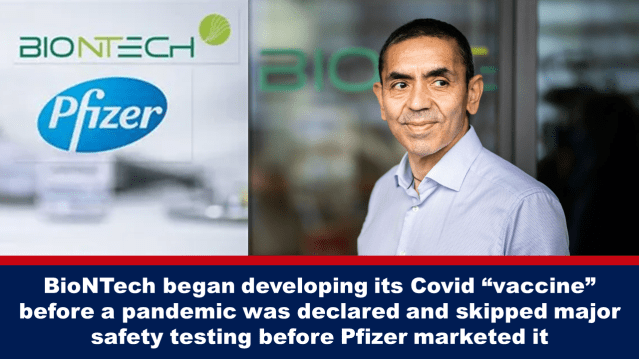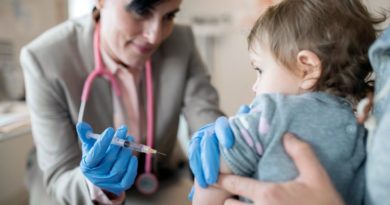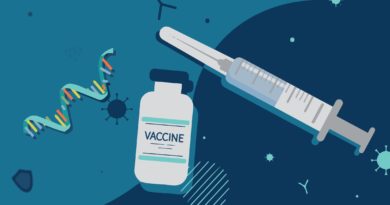BioNTech began developing its Covid “vaccine” before a pandemic was declared and skipped major safety testing before Pfizer marketed it
One of the myths and misconceptions about Pfizer is that it developed a covid vaccine. It didn’t. BioNTech developed the vaccine and Pfizer markets it.
In March 2022, 466 pages of Pfizer non-clinical submission (animal studies) to the US Food and Drug Administration was obtained by Judicial Watch in response to a Freedom of Information request. Sasha Latypova, a former executive of a pharmaceutical Contract Research Organisation, reviewed these documents for a second time at the beginning of the year. One of her findings was that “Pfizer waived major categories of safety testing for their product altogether using a self-serving interpretation of WHO recommendations from 2005.”
However, as Robert Kogon explains below, it is not Pfizer who developed the “vaccine,” but BioNTech. So, it is BioNTech that waived major categories of safety testing, not Pfizer.
Further reading:
Let’s not lose touch…Your Government and Big Tech are actively trying to censor the information reported by The Exposé to serve their own needs. Subscribe now to make sure you receive the latest uncensored news in your inbox…
The following is an article by Robert Kogon republished from the Brownstone Institute
In an informative Substack post, Sasha Latypova asks “Did Pfizer Perform Safety Testing for its Covid-19 mRNA Vaccine in Preclinical Studies?” and comes to the conclusion that the company simply skipped important categories of preclinical testing, i.e. testing on animals, in order to move on to the clinical, i.e. human, trials.
This is undoubtedly true, except that it was not Pfizer that did this, but rather BioNTech, the German firm that is the owner of what is erroneously known as the “Pfizer” vaccine and that was solely responsible for the preclinical program.
There is no need to take my word for it. The founders of BioNTech, CEO Ugur Sahin and CMO Özlem Türeci, say so themselves in The Vaccine: Inside the Race to Conquer the COVID-19 Pandemic: the auto-hagiographical account of their efforts to develop a Covid-19 vaccine that they co-authored with the journalist Joe Miller.
Thus, on page 43 of The Vaccine, we read that the preclinical phase of the drug’s development was “entirely under BioNTech’s control.” The 466-page FDA submission on the preclinical program discussed by Latypova is in fact Pfizer’s submission on BioNTech’s behalf.
As detailed in The Vaccine, BioNTech developed its preclinical program in consultations with the German regulatory agency, the Paul Ehrlich Institute (PEI), with which, as the book likewise makes clear (pp. 44-45), it already had a longstanding and, let’s say, somewhat cosy relationship. And Latypova is right – i.e., right about BioNTech even though she says “Pfizer” – BioNTech was indeed in a rush to get past the preclinical, animal testing, phase, in order to start with the human trials.
But this had nothing whatsoever to do with the US government’s Operation Warp Speed, as Latypova suggests. On Sahin and Türeci’s account, BioNTech launched its own project to develop a Covid-19 vaccine, dubbed “Project Lightspeed,” already in late January 2020 – less than a month after the first Covid-19 cases had been reported in Wuhan and before the outbreak had even been designated a pandemic by the WHO! This was, moreover, roughly five months before the US government would officially launch Operation Warp Speed in May.
Chapter 7 of The Vaccine, titled “First in Human,” narrates Sahin and Türeci’s fevered efforts to abbreviate the preclinical testing phase. On his own account, the need to complete a preclinical toxicology study on animals prior to injecting his vaccine candidate into humans was particularly irksome to Sahin. Sahin wanted the toxicology study rather “to be run simultaneously with clinical trials or skipped altogether” (p. 158).
Astonishingly, Germany’s PEI agreed to the former proposition – even though the whole point of the preclinical toxicology study is to make sure that it is safe to proceed to human trials! The justification given by BioNTech relied on a 2017 WHO draft report on vaccines for the far deadlier Ebola virus. The 2017 draft report as well as the 2018 final report (p. 132) suggest that interim data from an incomplete preclinical toxicology study “may be sufficient” to proceed to a Phase 1 clinical trial during a public health emergency.
It should be noted that all the foregoing transpired before BioNTech had even recruited Pfizer as a partner to shepherd its vaccine candidate through the clinical part of the authorisation process and commercialise it on some (but not all) markets once approved. According to Sahin and Türeci (p. 51), BioNTech first met with the PEI to discuss their plans on February 6. The preclinical toxicology study would get underway on March 17 (p. 161) – perhaps not coincidentally, the very day that the BioNTech-Pfizer collaboration agreement was concluded.
Barely one month later, on April 23, BioNTech itself would initiate a Phase 1 human trial in Germany and, n.b., still without any involvement of Pfizer. (The EU Clinical Trials Register entry is HERE.) According to Sahin and Türeci (p. 171), the requisite interim report on the preclinical toxicology study was completed in just two months.
But there is an obvious problem here: the dates do not add up. Two months from March 17 would take us to May 17. Contrary to the recommendation in the WHO Ebola vaccine report, BioNTech would appear to have moved on to human trials with the PEI’s blessing even before the interim report was completed.
As the FDA submission discussed by Latypova makes clear, several other categories of preclinical testing were simply omitted altogether. These include so-called safety pharmacology studies, which, per 2005 WHO guidelines, are intended to investigate the effects of a candidate vaccine on “physiological functions (e.g. central nervous system, respiratory, cardiovascular and renal functions) other than those of the immune system.”
It is these 2005 WHO guidelines that are cited by Pfizer in the FDA submission to justify the absence of any safety pharmacology studies. Among other places, the reference is found, for instance in an appendix that is titled precisely “Justification for the absence of studies.”
The same guidelines are also cited by the European Medicines Agency in its February 2021 Comirnaty assessment report, where it notes that “No safety pharmacology studies were conducted with BNT162b2. The Applicant refers to that they are not considered necessary according to the WHO guideline (WHO, 2005).” As is the case in the US Biologics License Application to the FDA, incidentally, “the applicant” here is BioNTech, not Pfizer.
But do the 2005 WHO guidelines in fact justify omitting the studies as “not necessary?” In his new book Die mRNA Maschine (The mRNA Machine), David O. Fischer examines the relevant passages of the WHO guidelines, as well as those of earlier 2001 EMA guidelines to which the WHO guidelines refer, and he comes to precisely the opposite conclusion: namely, that the guidelines require such studies, “in particular for novel pharmaceutical approaches” such as mRNA vaccines (p. 85).
Fischer (a pseudonym for a biologist and former pharma industry executive) writes: “By eliminating any sort of safety pharmacology studies, BioNTech violated these general requirements in a way that can only be described as brazen” (p. 85).
(Translations from German by the author.)
Postscript: As alluded to above, in their book, Ugur Sahin and Özlem Türeci claim that BioNTech’s Covid-19 vaccine project got underway on January 27, 2020. But documentary evidence released under the American Freedom of Information Act tells a different story. A BioNTech study report included in the so-called “Pfizer Documents” shows that BioNTech in fact already began animal testing on January 14 – just one day after the publication of the SARS-CoV-2 genome! See p. 8 of the report for the study dates.
Featured image: Ugur Sahin, Chairman of BioNTech from ‘New Covid-19 variant could raise the bar for achieving herd immunity, BioNTech CEO says’, CNN, 22 December 2020

This article has been archived for your research. The original version from The Exposé can be found here.



